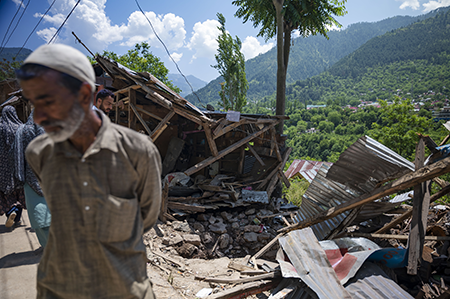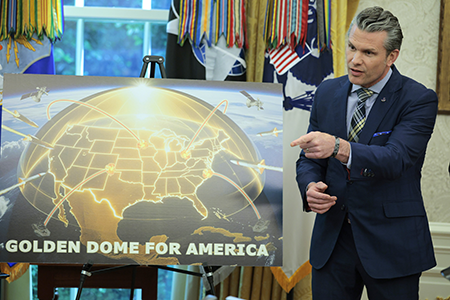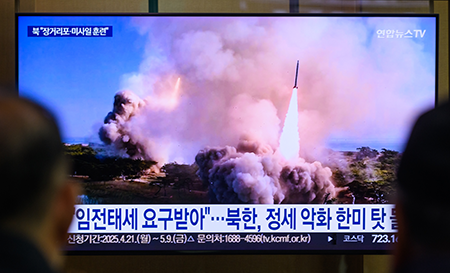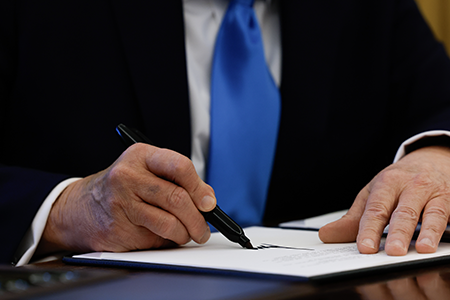It was the worst outbreak of direct military violence between the South Asian neighbors since the 1999 Kargil War.
June 2025
By Daryl Kimball and Xiaodon Liang
In a renewed flareup between nuclear-armed rivals, India and Pakistan fired conventionally armed missiles, drones, and artillery shells at each other in early May, in the worst outbreak of direct military violence between the South Asian neighbors since the 1999 Kargil War.

At the urging of top leaders from several states, including China, Iran, Saudi Arabia, the United Arab Emirates, the United Kingdom, and the United States, Indian Prime Minister Narendra Modi and Pakistan’s army chief, Gen. Syed Asim Munir, agreed to a ceasefire, halting the fighting before it might have led to a full-scale ground war and a nuclear exchange.
Between May 6 and May 10, the two sides struck military bases inside the disputed territory of Jammu and Kashmir, and beyond. On May 10, U.S. President Donald Trump announced that U.S. mediation had secured a ceasefire, which both sides confirmed later that afternoon.
The exchange of long-range attacks was preceded by a crisis that began April 22, when an armed group killed 26 civilians in Pahalgam, a town in Indian-controlled Kashmir. India claims the Pahalgam attack was carried out by “Pakistani and Pakistan-trained terrorists belonging to the Lashkar-e-Taiba” militant group, according to a May 7 statement by Foreign Secretary Vikram Misri. Pakistan denied involvement in the attack.
Following India’s April 24 announcement that it would suspend the Indus Waters Treaty, which governs rights to shared riparian waters, Pakistan declared that it would react with “full force across the complete spectrum of national power,” a not-so-veiled reference to the possible use of nuclear weapons.
Under increasing domestic pressure to retaliate, the Modi government launched a major air strike May 6 against alleged “terrorist infrastructure” at nine sites in Pakistani-controlled Kashmir and other provinces of Pakistan. Pakistan claimed in a May 8 press release that the attack led to 31 deaths and 57 injuries.
Pakistan says it shot down five Indian air force combat jets May 6, including several French Dassault Rafale fighters. Although India has not acknowledged these losses, U.S. officials told Reuters May 8 that Chinese-origin Pakistani aircraft had downed at least two Indian combat jets, one of which was a Rafale. A French intelligence official also confirmed the loss of at least one Rafale jet to CNN May 7.
Subsequent rounds of missile and drone attacks by each side against civilian and military targets were accompanied by reported shelling of military positions along the Line of Control, the de facto border in Kashmir.
In the early morning of May 10, Indian missiles and drones targeted several Pakistani air bases outside Kashmir, including Nur Khan air base in Rawalpindi, according to a Pakistani military spokesman. On the same day, Pakistan launched attacks against Indian air bases and BrahMos hypersonic cruise missile storage sites in Kashmir, Punjab, and Gujarat.
In a press release, the Indian government claimed that the Pakistani director-general of military operations reached out to offer a ceasefire in the afternoon. Pakistan disputes that it initiated contact.
“The Indians requested a ceasefire after the 8th and 9th of May after they started their operation. We told them we will communicate back after our retribution,” Pakistani Lt. Gen. Ahmed Sharif Chaudhry said at a May 11 press conference.
The two countries also dispute the extent to which the United States was involved in brokering a ceasefire agreement. Although Pakistani Prime Minister Shehbaz Sharif thanked U.S. officials for their diplomatic intervention in a May 10 social media post, Indian officials have maintained that ceasefire negotiations were bilateral.
Reporting by U.S. news outlets suggests that U.S. officials were actively engaged in defusing the crisis. U.S. Secretary of State Marco Rubio, who is also acting national security advisor, held multiple phone calls with Indian and Pakistani officials beginning May 6, according to Reuters. Rubio and Vice President J.D. Vance proposed a plan for U.S. intermediation to Trump on May 9, after which Vance spoke with Modi to express U.S. concerns of a “dramatic escalation,” an unnamed source told the newswire.
But top U.S. officials became particularly concerned after the alleged Indian strike on the Nur Khan air base, which is near Pakistani military headquarters and also the Strategic Plans Division, which oversees nuclear forces, The New York Times reported.
Pakistani Defense Minister Khawaja Muhammad Asif said his country would only use nuclear weapons if “there is a direct threat to our existence,” in an April 28 interview with Reuters. With approximately 170 nuclear warheads each, India and Pakistan have enough nuclear firepower to obliterate the other; Pakistani doctrine retains the option to use nuclear weapons first against non-nuclear military threats.
In previous crises sparked by terrorist attacks in India, New Delhi has shown more relative restraint in its response. In January 2016, after militants attacked the Pathankot air base in northern Punjab, Pakistan made initial steps to investigate and arrest suspects tied to the multiday assault.
When a Kashmiri militant attacked an Indian paramilitary convoy in February 2019 in the Pulwama district of Indian-controlled Kashmir, India launched air strikes against a suspected terrorist base in Pakistan, outside of the Pakistani-controlled portion of the disputed territory. But during that crisis, no military bases were targeted.
In the wake of the latest conflict, Indian and Pakistani officials sought to depict to their publics and the world that their respective military operations were responsible and successful. But the underlying factors that led to this war and previous nuclear-tinged crises since the tit-for-tat Indian and Pakistani nuclear tests of 1998 still appear to exist: the possibility of cross-border terrorism by anti-Indian militia groups, the absence of regular dialogue between the two governments, and the presence of nuclear weapons.
Since the ceasefire was concluded, India and Pakistan have traded threats and made accusations of nuclear-weapons mismanagement. On May 12, Modi said India would strike at militant hideouts across the border again if there were new attacks on India and would not be deterred by what he referred to as Islamabad’s “nuclear blackmail.”
On May 15, Indian Defense Minister Rajnath Singh questioned the safety of nuclear weapons in Pakistan, calling it an “irresponsible and rogue nation.”“I believe that Pakistan’s nuclear weapons should be taken under the supervision of [the International Atomic Energy Agency],” Singh said.
In response, Pakistan’s Foreign Affairs Ministry said in a statement that Singh had revealed his “profound insecurity and frustration regarding Pakistan’s effective defence and deterrence.”
The accusation came shortly before U.S. President Donald Trump unveiled further details of his ‘Golden Dome’ missile defense system.
June 2025
By Xiaodon Liang
In an extended criticism of the Trump administration’s “deeply destabilizing” plans for a homeland missile defense shield, Beijing and Moscow allege that Washington is deliberately acquiring a “first strike” capability that creates “hardly surmountable obstacles to the constructive consideration of nuclear arms control and nuclear disarmament initiatives.”

The accusation, contained in a May 8 joint statement on global strategic stability, came shortly before U.S. President Donald Trump unveiled further details of his “Golden Dome” missile defense system (See ACT, March 2025). The new system “will be capable of intercepting missiles even if they are launched from other sides of the world and even if they are launched from space,” Trump announced May 20 at a White House press conference.
Gen. Michael Guetlein, the vice chief of operations at the U.S. Space Force, will lead the Golden Dome program, Trump said.
His comments focused primarily on a system of space-based interceptors for boost-phase intercept of adversary missiles, which Trump says will cost $175 billion and three years to complete. But in a separate statement issued by the Defense Department following the press conference, Defense Secretary Pete Hegseth said the Golden Dome will be a “system of systems” that “is designed to leverage some past investments.”
“All of the systems comprising the Golden Dome architecture will need to be seamlessly integrated,” Hegseth said. It “will be fielded in phases, prioritizing defense where the threat is greatest.”
Andrea Yaffe, the acting principal deputy assistant secretary of defense for space policy, told senators May 13 that the department has developed several missile defense architecture options, which were then presented by Hegseth to Trump. Yaffe spoke in response to questioning by Sen. Mark Kelly (D-Ariz.) in a hearing before the Strategic Forces subcommittee of the Senate Armed Services Committee.
Although that key subcommittee is split over the merits of the president’s missile defense plan, senators acknowledged that a full assessment of the architecture would require more detail when the full defense budget arrives.
The “economics don’t work,” said Sen. Angus King (I-Maine), the subcommittee’s ranking member, pressing Yaffe and other officials to explain how a missile defense shield could defend against a Chinese or Russian strike involving hundreds or thousands of missiles.
At the request of the subcommittee, the Congressional Budget Office (CBO) published estimates May 5 indicating that a system of space-based interceptors would cost between $161 billion and $542 billion over 20 years, depending on requirements and design decisions. The CBO cautioned, however, that these estimates were derived from plans originally formulated to address the threat of “one or two [intercontinental ballistic missiles] ICBMs fired by North Korea.”
Asked May 15 about the upper estimate of $542 billion at the POLITICO 2025 Security Summit, Gen. B. Chance Saltzman, the chief of space operations, said, “I’ve never seen an early estimate that was too high.”
In their May 8 statement, Chinese President Xi Jinping and Russian President Vladimir Putin characterized the Golden Dome project as a rejection of the “inseparable interrelationship between strategic offensive arms and strategic defensive arms, which is one of the central and fundamental principles of maintaining global strategic stability.”
The statement was issued during a visit by Xi to Moscow to attend commemorations of the 80th anniversary of the end of the Second World War in Europe and the founding of the United Nations.
In past joint statements, the two countries have expressed brief concerns about U.S. missile defense plans. For example, in a June 2019 statement on strengthening contemporary global strategic stability, the two sides said that U.S. missile defense plans would have an “extremely negative effect on international and regional strategic balance, security and stability.”
But the new statement from May 2025 is more specific and much lengthier, outlining concerns that the United States is developing the capability to use “high-precision conventional weapons or a combination of nuclear and non-nuclear weapon systems” to launch a strike against the strategic nuclear forces of Beijing or Moscow. Golden Dome would then, in this hypothetical scenario, intercept a “radically weakened retaliatory strike with air and missile defense assets.”
The aspiration of the United States to “ensure an overwhelming military superiority … fundamentally contradicts the logic underlying the maintenance of strategic balance,” the joint statement claims.
Although China and Russia have missile defense capabilities, neither country has articulated plans for large-scale homeland strategic missile defense. China has tested its Chinese Dongneng-3 interceptor against an intermediate-range target, while Russia maintains a local missile defense system around Moscow that can intercept a limited number of intercontinental ballistic missiles.
The most advanced Russian mobile air and missile defense system, the S-500, is designed to intercept intermediate-range ballistic missiles.
As an Atlantic Council report in February noted, Russian missile defense investments are focused on “protecting Russian leadership, critical command and control, and nuclear forces.”
Pyongyong acted after criticizing Washington for conducting a drill that simulated a North Korean nuclear strike on the U.S. homeland.
June 2025
By Kelsey Davenport
North Korea conducted missile drills simulating a nuclear counterstrike against U.S. and South Korean forces after criticizing the United States for conducting a drill that simulated a North Korean nuclear strike on the U.S. homeland.

The U.S. exercise simulated the interception of an incoming intercontinental ballistic missile (ICBM). It was conducted at Fort Greely, Alaska, during a visit by Secretary of the Army Dan Driscoll April 23-24. Fort Greely houses interceptor missiles as part of the U.S. Ground-Based Midcourse (GMD) missile defense system.
Driscoll was briefed on GMD procedures during a “simulated ICBM attack against the United States,” according to a U.S. Army statement. The statement did not specify if the ICBMs in the simulated attack came from North Korea, but the interceptors at Fort Greely likely would be used in the event of North Korea firing nuclear-armed ICBMs at the United States.
A May 3 commentary in North Korea’s state-run Korean Central News Agency (KCNA) said that the U.S. “interceptor drill simulating the so-called ICBM attack of an enemy state … is, in essence, a military action of an offensive nature that made a nuclear war with [North Korea] a fait accompli.”
The commentary argued that the United States does not need to conduct a drill simulating the interception of a North Korean ICBM if Washington “does not seek a nuclear war” with Pyongyang.
The “best option for deterring the danger of the outbreak of a nuclear war” is to build up the “strongest offensive and defensive power capable of overwhelmingly suppressing any form of military threat posed by the U.S. arms buildup directly aiming at” North Korea, the commentary said.
North Korea used the drill as justification for its May 8 exercises simulating a nuclear counterstrike on U.S. and South Korean forces. North Korean leader Kim Jong Un oversaw the exercises, which included short-range ballistic missiles capable of delivering tactical nuclear warheads.
According to a May 9 KCNA statement, U.S. and South Korea military exercises require “that the armed forces of [North Korea] maintain a rapid reaction capability and a thoroughgoing war posture.”
The drills were designed to verify the command and mobilization of North Korea’s nuclear missiles.
According to the commentary, Kim said that it is “very important to steadily perfect the normal combat readiness of the nuclear force.” He also called for “further raising the combat reliability of the tactical nuclear weapon systems.”
South Korea’s June 3 presidential election may offer an opportunity for de-escalating tensions on the Korean peninsula. The two candidates, Lee Jae-myung from the Democratic Party and Kim Moon-soo from the People Power Party, both call for a strong South Korean alliance with the United States.
Kim Min-soo called for enhancing South Korea’s role in U.S. extended deterrence and raised the prospect of South Korea developing its own nuclear deterrent.
Lee, however, called for greater cooperation with North Korea and strengthening inter-Korean relations to reduce tensions. He expressed support for the denuclearization of the Korean peninsula using a phased approach that reduces military tensions and enhances stability. He also said he would restore an inter-Korean military agreement reached in 2018 that both countries subsequently suspended.
Although North Korea is primarily focused on the threat posed by the United States, it has raised concerns about Japanese military activities, particularly the country’s investment in missile capabilities.
In a May 10 KCNA commentary, North Korea called attention to a missile drill that Japan is preparing for late June and to Japan’s plans to expand its missile force.
Japan’s Ground Self-Defense Force’s 1st Artillery Brigade is planning its first long-range missile drill from within Japanese territorial waters. The test will involve firing surface-to-ship training missiles at a target off the coast of the country’s northernmost island.
The drill is for training purposes and reflects the “severe security environment” of the region, Japanese Defense Minister Gen Nakatani said in April.
KCNA said that Japan’s possession of missiles that are capable of attacking enemy bases in foreign countries demonstrates that the country is not focused on “exclusive defence.”
The missile developments are “proof that Japan’s reckless moves for overseas aggression have become more courageous,” the KCNA commentary said.
U.S. President Donald Trump voiced optimism about a possible Iran nuclear deal, but there still appear to be significant differences over the scope of the agreement.
June 2025
By Kelsey Davenport
President Donald Trump said the United States and Iran are close to reaching a nuclear agreement after the two sides met for a fourth round of talks in Oman, but there still appear to be significant differences over the scope of the agreement.

During a May 15 business roundtable in Doha, Trump said that Iran has “sort of agreed to the terms” of a deal and will not make “nuclear dust.” Trump did not specify what “nuclear dust” is, but he may have been referring to Iran’s capabilities to enrich uranium.
Iranian officials have stated consistently that Tehran is willing to limit its enrichment program in an agreement with the United States but will not give up the capability entirely.
The United States has sent mixed messages about its position on Iran’s uranium enrichment program. After the first round of negotiations in April, Trump’s lead negotiator, U.S. Special Envoy for the Middle East Steve Witkoff, suggested that the United States could agree to a deal that allows Iran to continue enrichment, but later said a deal would prohibit enrichment. (See ACT, May 2025.)
Trump also has been inconsistent on the issue of enrichment. He told Meet the Press May 4 that “total dismantlement” of the nuclear program is “all I would accept.” He suggested that Iran does not need nuclear energy because of its oil reserves. But on May 7, when asked specifically about allowing Iran to retain a limited enrichment program, Trump said “we haven’t made that decision yet.”
Ali Shamkhani, an adviser to Iranian Supreme Leader Ayatollah Ali Khamenei, said in a May 14 interview with NBC that Iran is ready to sign a deal with the United States and reiterated that Iran is willing to limit uranium enrichment to low levels. He previously suggested in a May 7 post on X that any deal should include a “recognition of Iran’s right to industrial enrichment.” That recognition, plus the removal of U.S. and international sanctions, “can guarantee a deal,” Shamkhani said.
Iran is enriching uranium up to 60 percent uranium-235. Iran has no civil justification for enriching up to this level and could quickly enrich that material to weapons-grade levels, or 90 percent U-235.
Shamkhani said that Iran is willing to dispose of its stockpiles of highly enriched uranium and accept more intrusive monitoring by the International Atomic Energy Agency in exchange for the lifting of sanctions. Under the 2015 nuclear deal between Iran and the multilateral group known as the P5+1 (China, France, Germany, Russia, the United Kingdom, and the United States), Iran agreed to limit uranium enrichment to 3.67 percent U-235, a level suitable for power reactors; cap the stockpile of enriched material to about 200 kilograms; and restrict uranium enrichment capacity.
Trump reposted NBC’s report on Shamkhani’s interview on Truth Social.
The comments by Trump and Shamkhani followed a fourth round of negotiations between Witkoff and Iranian Foreign Minister Abbas Araghchi.
Araghchi described the May 11 talks in Oman as “more serious and candid” and told Iranian media that the sides now better understand each other’s positions.
He said Iran’s uranium enrichment program “must continue” under a deal, but the “scope and level may change.” Iran will not compromise on enrichment, he said. Before the talks he complained that the “constant change” in U.S. positions was a problem.
A senior U.S. official said the fourth round of talks was encouraging and the two sides agreed to continue working on “technical elements” of a deal.
Tehran may be considering regional options for addressing the question of enrichment. During the negotiations, Iran put forward a proposal to operate a joint uranium enrichment facility with Saudi Arabia and the United Arab Emirates, according to several Iranian news outlets. It is unclear how such a joint venture would work, but Iran may view a multilateral endeavor as less of a proliferation risk because additional states would be involved with the uranium enrichment program.
The United States denied that there were any discussions of a joint venture on uranium enrichment in Oman, and it is unclear if Saudi Arabia or the UAE would support such a plan.
The UAE operates four nuclear power reactors, and Saudi Arabia has announced plans to build two reactor units. Both countries expressed support for a nuclear deal with Iran.
During Trump’s May 13 visit to Riyadh, he said that a U.S.-Iran nuclear deal will “make your region and the world a safer place.”
Trump emphasized that there is not much time for negotiations and that Iran will continue to face economic pressure if there is no deal.
As part of the Trump administration’s ongoing pressure campaign, the U.S. State Department announced new sanctions on Iranian entities connected to the Organization of Defense Innovation and Research, which has ties to the organized nuclear weapons program in Iran that ended in 2003.
According to the May 12 department release, the sanctioned persons are involved in activities that “materially contribute to, or pose a risk of materially contributing to, the proliferation of weapons of mass destruction.”
The release also noted that Iran “continues to substantially expand its nuclear program and carry out dual-use research and development activities applicable to nuclear weapons.”
